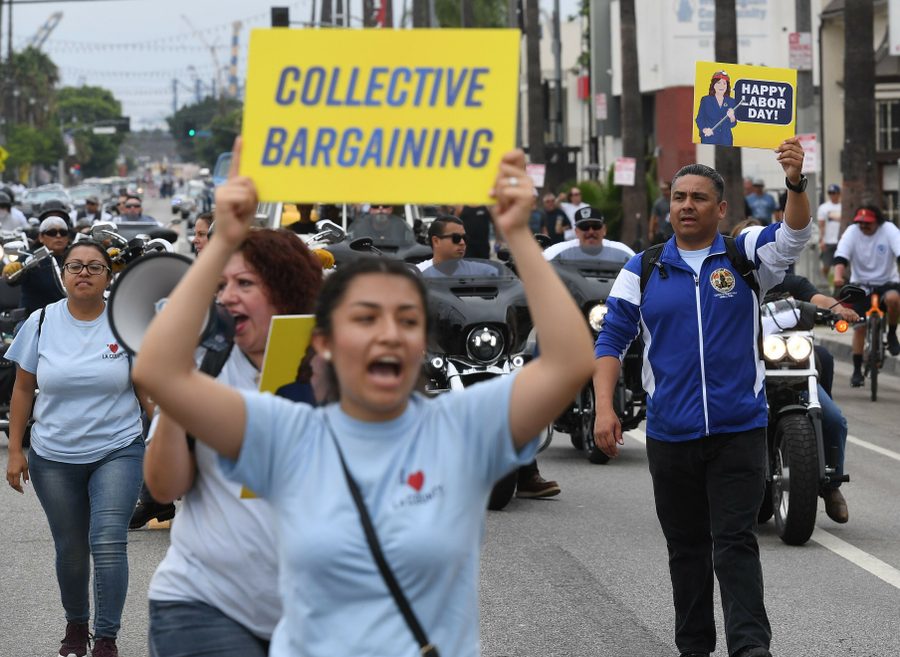Union Density Went Up Last Year! Don't Get Too Excited.
When you do the math, the story is not as great as it seems.
Hamilton Nolan

Last week, labor unions got some uncommonly good news: The government’s annual survey showed that union density in America actually rose by a full half point in 2020, a rare reversal of a long-term trend of decline. Should unions be celebrating their work? Actually, no!
Union density — the percentage of working people who are union members — has been broadly declining for decades. At its high point in the 1950s, about a third of American workers were union members. By the 1980s, it had fallen to about a fifth. And now, it is down to barely more than a tenth. This long-term trend is the single biggest problem facing unions in America. If they do not turn it around, they will die out, or shrink down into single-digit numbers that will render unions (more) unable to exert meaningful strength on behalf of the working class. Raising union density, in other words, is an absolutely vital task that unions fail at year after year.
So you can imagine that seeing the Bureau of Labor Statistics say in its yearly report last week that “the percent of wage and salary workers who were members of unions — the union membership rate — was 10.8 percent, up by 0.5 percentage point from 2019” was big news for unions. Indeed, the AFL-CIO declared that “We believe this increase is part of a national groundswell.” In the midst of a terrible pandemic, with widespread unemployment, union density actually rose. Victory! Success! Vindication at last!
But hold on there. Here was another fact in the BLS’s annual numbers: “The number of wage and salary workers belonging to unions, at 14.3 million in 2020, was down by 321,000, or 2.2 percent, from 2019.” So while union density went up, the total number of union members went down. Put a hold on all the party favors, please. What’s going on here?
As Heidi Shierholz, a labor economist and the director of policy at the Economic Policy Institute explained to me, two factors at work in 2020 created this weird disparity. One is what she calls the “pandemic composition effect,” which means that the industries that lost the most jobs last year thanks to the pandemic were industries that tended to have low unionization rates — bars, restaurants, hospitality, etcetera. The second factor was that unionized workers were less likely to lose their jobs than non-union workers in the same industry. Each of those two factors was responsible for about half of the increase in union density. So even as hundreds of thousands of union jobs were lost, union members were less impacted than the economy as a whole, which produced the mathematical trick of an appearance of progress. (It is worth noting, too, that assuming that jobs come back to the same hard-hit industries when the pandemic is over, that will serve to dilute and reduce last year’s union density gains.)
“I don’t want to act like this was a good year for unions. This was a really bad year in the labor market across the board. Everyone got hit hard,” Shierholz said. “But the main message was that non-union members got hit harder than union members.”
The honest takeaways for unions in 2020 are these:
1. Unions demonstrated their value, by helping to protect their existing members from job losses.
2. Whatever new organizing unions did in 2020 was not even close to the amount necessary to balance out the number of union members that were lost.
3. Nothing that happened in 2020 indicates that unions have a functional ability to turn around their long-term decline.
Every year, when the BLS union numbers come out, the union establishment rushes to issue press releases putting some positive spin on them, no matter how depressing they might be. This actually hurts the cause. We need brutal honesty. That is the only way to instill the appropriate amount of urgency in the wounded labor movement. It would be nice, for once, to hear the AFL-CIO say something like, “Unions proved their value in 2020. But our membership numbers are still heading in the wrong direction. It is absolutely vital we turn those numbers around. Here is our plan for doing so.”
The closest that Richard Trumka came to doing that this year was to call for passing the PRO Act, which would wonderfully reform labor law. Yeah, that would be great. But guess what? This Congress is not going to pass the PRO Act. So please — let’s make a better plan before next year’s numbers come out.
Hamilton Nolan is a labor writer for In These Times. He has spent the past decade writing about labor and politics for Gawker, Splinter, The Guardian, and elsewhere. More of his work is on Substack.








